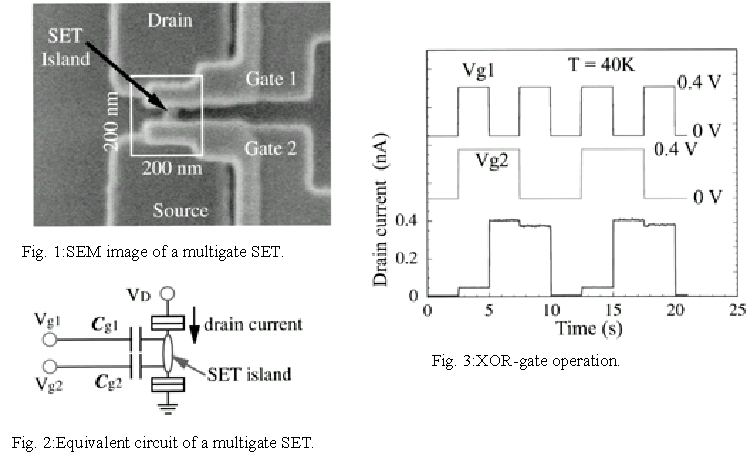
Multigate Single-Electron Transistor: Application to an Exclusive-OR Gate
Yasuo Takahashi, Akira Fujiwara, Kenji Yamazaki, and Katsumi Murase
Device Physics Laboratory
The single-electron transistor (SET) is one of the best candidates for future extremely large-scale-integrated circuits because of its ultralow power consumption and small size, which results from its ability to manipulate a single electron at a time. Although some circuit applications in which SETs are used instead of conventional MOSFETs have been proposed, they do not use the powerful advantages of SETs and need the same number of transistors as the CMOS logic circuit. Actually, the SET has completely different characteristics than the MOSFET. One is that the SET can inherently have multiple gates. Another is that the SET exhibits an oscillatory conductance as a function of the gate voltage. These characteristics give the SET the capability of functioning as an exclusive-OR (XOR) gate.
An SEM image of a multigate SET we fabricated is shown in Fig. 1. A small one-dimensional Si wire fabricated on an SOI wafer was converted into a small SET island by means of pattern-dependent oxidation (PADOX) [1]. Two ultrafine gate electrodes were attached to this island. The equivalent circuit of the device is shown in Fig. 2; the two gate capacitances (Cg1 and Cg2) are almost equal due to the symmetric structure of the gates. Figure 3 shows the drain-current switching measured at 40 K in response to the switching of the two input-gate voltages between 0 and 0.4 V. Low current levels were obtained only when both input voltages were high or low. This demonstrates successful XOR-gate operation [2]. The XOR gate using conventional logic circuits needs 16 transistors, whereas this function can be implemented with just one SET.
[1] Y. Takahashi et al., IEEE Trans. Electron Devices, 31(1996) 1213.
[2] Y. Takahashi et al., IEDM Technical Digest (1998) 127.
